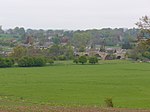Chesters Bridge
Bridges in NorthumberlandBridges in Roman BritainCrossings of the River TyneEnglish Heritage sites in NorthumberlandForts of Hadrian's Wall ... and 2 more
Roman sites in NorthumberlandUse British English from March 2017
Chesters Bridge was a Roman bridge over the River North Tyne at Chollerford, Northumberland, England, and adjacent to the Roman fort of Cilurnum on Hadrian's Wall. The fort, mentioned in the Notitia Dignitatum, and now identified with the fort found at Chesters, was known as Cilurnum or Cilurvum. In 2016, public access to Chesters Roman bridge abutments was suspended due to flood damage.
Excerpt from the Wikipedia article Chesters Bridge (License: CC BY-SA 3.0, Authors).Chesters Bridge
Military Road,
Geographical coordinates (GPS) Address Nearby Places Show on map
Geographical coordinates (GPS)
| Latitude | Longitude |
|---|---|
| N 55.025 ° | E -2.138 ° |
Address
Chesters Roman Fort
Military Road
NE46 4BQ , Humshaugh
England, United Kingdom
Open on Google Maps









